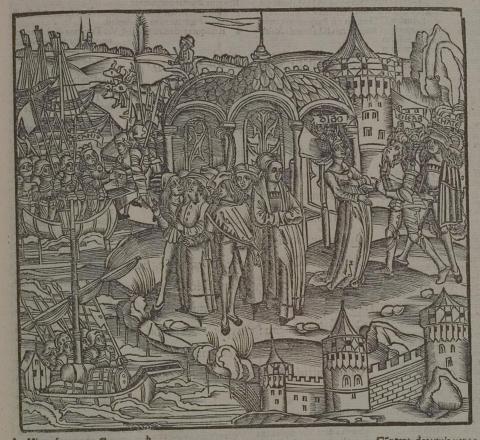Annotations
On the right, Aeneas and Achates approach Dido (588-94), who has just received the lost men of Aeneas. These men, who include Cloanthus and Ilioneus, unlabeled, stand in the center of the image with a few of Dido's attendants; they stand in front of the Temple of Juno. Behind the temple of Juno, a man drives livestock, possibly a representation of those mentioned in line 633-5 (Nec minus intereā sociīs ad lītora mittit/vīgintī taurōs, magnōrum horrentia centum/terga suum, pinguīs centum cum mātribus agnōs). There appear to be a few oxen and possibly a pig. On the left, men arrive at Aeneas's ships to tell Ascanius the good news (645-6), which is that Dido has welcomed them generously. In the lower left corner is a ship that represents Aeneas's lost ships, the ones led by Cloanthus, Ilioneus and the others. Below Dido and Aeneas is a representation of a city wall. (Katy Purington)
Woodcut illustration from the “Strasbourg Vergil,” edited by Sebastian Brant: Publii Virgilii Maronis Opera cum quinque vulgatis commentariis expolitissimisque figuris atque imaginibus nuper per Sebastianum Brant superadditis (Strasbourg: Johannis Grieninger, 1502), fol. 149r, executed by an anonymous engraver under the direction of Brant.


Sebastian Brant (1458–1521) was a humanist scholar of many competencies. Trained in classics and law at the University of Basel, Brant later lectured in jurisprudence there and practiced law in his native city of Strasbourg. While his satirical poem Das Narrenschiff won him considerable standing as a writer, his role in the transmission of Virgil to the Renaissance was at least as important. In 1502 he and Strasbourg printer Johannes Grüninger produced a major edition of Virgil’s works, along with Donatus’ Life and the commentaries of Servius, Landino, and Calderini, with more than two hundred woodcut illustrations. (Annabel Patterson)